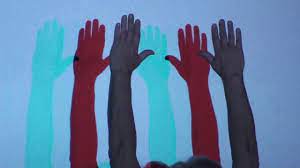Jacqui O’Reilly – Return from Erasure + Louise Curham – Crevice communities – extending the life of expanded cinema
2.30pm Tues Dec 6, Wagga Wagga Art Gallery
Jacqui O’Reilly
Return from Erasure, 2022
Composition for live performance, sound, moving image,15 minutes.

This electro-acoustic sound & moving image performance is designed for an immersive and reflexive time based experience and connects to the work of the same name exhibited at the Crevice Communities Exhibition 2021. Drawing on deep listening as research, the work includes audio artefacts from past online zoom meetings as sampled compositional material. During these zoom meetings, the artist engaged in kōrero (discussion) to build relationships with Māori and learn about tangata whenua (people of the land) in the Māori sense. The resulting composition is a speculative live work that asks how might we listen to the sound of decolonisation as a synthesis of relationality? Engagement with the work brings emphasis to the present moment as the signal for continuous movement beyond ongoing processes of systemic colonisation. A paper about the research and methodologies behind this work will be presented at the Crevice Communities Symposium on Wednesday 7 December.
Jacqui O’Reilly is a Pākehā artist, researcher and musician from Aotearoa New Zealand, now based in Sydney on the land of the Gadigal people of the Eora Nation. Her practice explores relations between people, place, media and perception and she is interested in the creative act as acknowledgement of past happenings and as reparative futuring.

Louise Curham
Two 16mm film performances
Note: the following performance did not take place due to Louise contracting Covid in the days prior. This information is left here for information only.
Some art takes place in small, little-known, interdependent communities – crevices. In Australia, expanded cinema has flourished in crevices but that makes its practice and history precarious. Its crevice status points to a habit in Australian art of overlooking what has flourished locally.
For over a decade, the artist-archivist collaboration Teaching and Learning Cinema has re-enacted expanded cinema media-based art that joins experimental film, performance and conceptual art, taking a mix-all-the-arts, participatory attitude. In some works, light bulbs flash in the room as the film is projected, forcing the audience to pay attention to the room, each other and the watching process. In others, there is no film image at all, just a 24 hour duration, frosted windows and a lightbulb.
Key to this work is that it is made within communities and scenes. The works are not stable objects that can be readily collected, not easy to bring out for future audiences. Through re-enactment TLC accesses historical works, producing ‘user’s manuals’ during the re-enactment process that encourage others to try the works themselves.
The two performances that will be re-enacted by Dr Louise Curham highlight both the original works themselves and the process that’s taken place to enable them to be performed by someone other than the artists who originally made them. This is exciting because without this authoritative instruction-making process, these artworks can’t be shown without the presence of the original artist.

Autumn Fog by Lynn Loo (2010–) duration 15 minutes – silent.
16mm double projection focused on plant footage.

Horror Film 1 by Malcolm Le Grice (1971-) duration 12 minutes – audio
Triple projection of abstract colour. Audio consists of the sound of breathing.
Louise Curham is a lecturer in the School of Information and Communication Studies, Charles Sturt University.